IAAC ERASING BORDERS FESTIVAL OF INDIAN DANCE OUTDOORS
hosted by
Erasing Borders Festival of Indian Dance Outdoor Concert
Robert J Wagner Park, 20 Battery Place, NYC
Tuesday August 15, 2017
The Concert is FREE and OPEN TO THE PUBLIC
Click here for Map |
| |
| Narrator or Sutradhar (‘carrier of the thread’): RAJIKA PURI |
 |
trained in Bharatanatyam and Odissi, is now known for the form of danced storytelling in which she narrates a text in English – and also sings, chants – as she dances. She is much in demand for her illustrated lectures. |
| |
|
| VIRAJA and SHYAMJITH KIRAN (Bharatanatyam) |
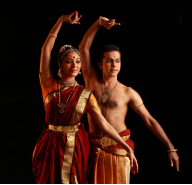 |
were last seen in NY in a full recital of their innovative Bharatanatyam choreography at the ‘Drive East’ Festival 2016. Trained at the prestigious Kalakshetra Foundation, Chennai, they are in worldwide demand as performers and also as choreographers and teachers.
Ganesh Vandana -The swaying, gentle, elephant-headed one exudes wisdom and benevolence, brings prosperity and bestows auspiciousness. As remover of obstacles, he is invoked at the beginning of all ventures.
Tejonidhi Loh Gol - is a famous Marathi Natyasangeet’ (‘song for theater’) that plays with the concepts of the sun as symbol of light and enlightenment and the lotus as symbol of spiritual awakening and beauty, and highlights the love-tie between them. |
| |
| SRUTHI MOHAN (Mohiniyattam) |
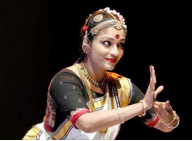 |
began training in Mohiniyattam with Kalamandalam Ashokan at the age of 12 and has, since, performed on various stages all over India, the Middle East and USA. Deeply involved in the spiritual – and cultural - life of Austin, TX, she dedicates her own art life to dancing within temples and at select sacred festivals.
Lalitha Lavanga ‘magic of springtime’ - is danced to a much loved poem by 13th century Saint-poet Jayadeva, in which Radha’s confidante drives her mad with longing for Krishna as she describes the sights, sounds, and perfumes of a woodland in springtime: swaying creepers, buzzing bees, singing cuckoos. |
| |
|
| DIMPLE SAIKIA (Assamese Sattriya & Ankia Naat). |
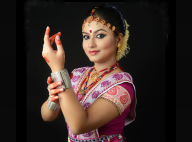 |
began learning Sattriya dance from her father, Guru Gobinda Saikia, at the age of 7 and has been performing for the last twenty years on TV and at dance festivals all over India. Her winsome personality and deep entrenchment in Assamese music, dance and storytelling give us an entrancing entry to this land of northeastern India.
Megha Syamala Murtim and Kanai kinu ruposiya
Following an invocation to the mischievous child Krishna, we watch the beloved, stories of the ‘dark lord’s childhood – how he steals buttermilk or subdues the poisonous serpent Kaliya – retold through Assamese music and dance. |
| |
|
| AAKANSHA MAHESHWARI and MALINI TANEJA (Rajasthani folk) |
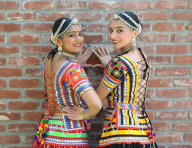 |
both trained in Indian folk and popular forms like Rajasthani Kalbelia and Bollywood dance, were first grounded in classical Bharatanatyam. They are also part of the hugely popular ‘Festival of Colors’ that tours many western states.
Lolee - Dancing to a song popularized by a Manganiyar bard, Mame Khan, two Rajasthani village women, try to awaken a baby as if he were Yashoda’s baby, Lord Krishna. Watching him open his eyes, and remembering the pranks he plays, they are filled with love.
Kalyo - is one of the best-known songs from a tribe of traditional snake charmers, the Kalbelias of Rajasthan. The dance features women spinning in their traditional long black skirts and is renowned for its lithe, lively movements. |
| |
|
| KALAMANDIR DANCE (Contemporary Indian) |
 |
is a NY-based contemporary dance ensemble that uses the vocabulary of classical Indian dance – as well as Western dance traditions - to explore new spaces of artistic expression. The movement language for their works is developed as a collective effort that aims to communicate across cultures.
one to(o) many colors (Excerpt) explores how a lack of connectedness with other beings affects us in different ways. Inspired by the work of Toronto-based photographer and writer Rupi Kaur – and a Ted Talk by Kolby Harrell, it strives to navigate that space, and discover different colors within us. |
| |
|
| KALANIDHI DANCE (Kuchipudi) |
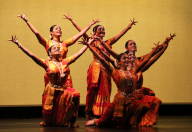 |
Under the direction of award-winning artist Anuradha Nehru, Kalanidhi Dance captivates with exquisite performances that push Kuchipudi in new and exciting directions. The NY Times calls them a “combination of bright energy, full-bodied sweetness and rapid precision” . . . “a rare amalgam of prime dance virtues.”
Why We Dance: Freedom - While the whole work expresses in movement – and words – what inspires the dancers to dance, Freedom shows how dance presents a respite from the monotony of daily life – a gift that makes the world disappear. |
|
|
| |
|

